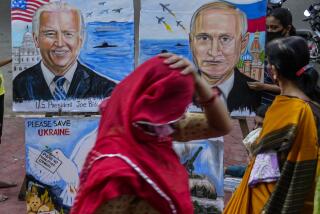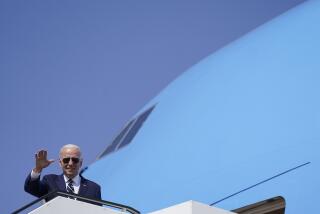THE FINAL CURTAIN : In Moscow’s Back Yard, Strategic Borders Are Suddenly Blurred : REGIONAL PERSPECTIVE: SOUTH ASIA
NEW DELHI — A senior and usually staid official of the Indian Foreign Ministry was quietly sipping his Scotch and soda at a recent cocktail party in the capital, when, inevitably, the conversation turned to the collapse of the nearby empire that for so long has so profoundly influenced the fate and direction of his own nation.
“Yes, of course, it is a disastrous and terrible thing that is happening up there,” he said of the old Soviet Union, the country that has been India’s most consistent and loyal ally and strategic provider through four decades of independence.
Then he grew suddenly animated: “But my God, man, think of the opportunities. Think of it. This superpower that has been the biggest force in our region is simply no more. The possibilities are now almost endless--for us, for Pakistan, for Iran, for the entire region.
“Look at it like this. Imagine if one day the United States suddenly broke up into little pieces. What would be the impact on Mexico, on Central America, on Brazil, on all of South America? Just try to imagine the jockeying for power, for territorial influence, the new alliances, the radical shifts in trading patterns. Well, it is a little like this for us.”
The analogy is, indeed, a compelling one.
Since the day V.I. Lenin’s Bolshevik army firmly planted the red flag in Tashkent more than seven decades ago, consolidating Communist rule over the vast region long known as Soviet Central Asia, the Kremlin time and again has asserted its muscle and money in the impoverished nations that lay to the south.
Acting sometimes paternally, other times fraternally and still others outright brutally, Moscow consistently has sought to embrace South Asia solidly within its sphere of influence--a policy not unlike that of the United States in Latin America.
As long ago as the 1920s, for example, Lenin used Tashkent as a base for an ambitious, though ill-fated, attempt to recruit and train an armed, Indian insurgent force to overthrow the British colonialists who, for a century and a half, ruled the vast subcontinent.
After partition and independence for Pakistan and India in 1947, Moscow spent tens of billions of dollars on arms supplies, power plants, factories and the heavy infrastructure for other major industries as part of a strategy designed to reinforce India’s socialist drift.
Just as the United States clandestinely or openly backed right-wing insurgencies in leftist nations such as Nicaragua, the Soviets helped finance leftist rebellions and political factions in Pakistan, which found itself forced into the U.S. sphere of influence after three wars with Soviet-supplied India.
And, while the United States was helping install or protect rightist, pro-American regimes in Chile and El Salvador, Moscow provided the muscle for a Communist takeover in Afghanistan, later invading the country with 110,000 occupation troops who spent 10 years there unsuccessfully fighting to put down a U.S.-backed Islamic rebellion.
In the last few months, however, it’s as if the entire strategic map of the region has been erased, leaving behind nations, regimes and political factions that now appear, at least on the surface, to have been orphaned virtually overnight.
In the Afghan capital of Kabul, the Soviet lifeline that has helped strongman President Najibullah survive against a continuing onslaught by Islamic rebels was finally cut this month, when the last Soviet military transport plane left for home, collapsing an air bridge that had funneled tens of billions of dollars in materiel to the Afghan armed forces. The United States, too, is to stop all arms deliveries to the Pakistan-based Afghan moujahedeen rebels by today, completing an agreement known as “negative symmetry” that was signed last September by Secretary of State James A. Baker III and then-Soviet Foreign Minister Boris D. Pankin.
Both sides in the Afghan civil war are believed to have enough arms stockpiled to endure at least another year or two of fighting, but the collapse of the Soviet Union is likely to take an even heavier toll on Najibullah’s beleaguered regime.
One of Najibullah’s harshest Soviet critics through the years has been Russian President Boris N. Yeltsin, who has pushed for an end to all Soviet involvement in Kabul’s affairs. As Yeltsin’s power has grown, Najibullah has lost his handful of remaining supporters in the Soviet army. Now, some analysts in the region believe that Afghanistan’s national obituary may soon follow that of its former benefactor, with any semblance of central authority giving way to the ethnic, tribal and regional divisions that Najibullah’s harsh dictatorship had controlled with an iron fist.
While Afghanistan may be the most obvious regional orphan left by the death of the Soviet empire, India, too, faces a painful period of mourning.
The nation’s powerful armed forces, a highly professional fighting force that ranks fourth in the world and gives India’s its much-sought-after image as a regional superpower, is likely to be hard hit.
It is predominantly Soviet-supplied after decades of highly favorable military sales arrangements with Moscow.
And New Delhi’s desire to diversify its military by purchasing more sophisticated weapons systems from the United States and other Western countries will be hampered by its own economic crisis--a foreign debt that now ranks as the world’s second-largest and chronic shortages of foreign exchange.
Pakistan, too, will suffer--albeit indirectly--from the Soviet Union’s demise. Traditionally a crucial, front-line state used by the United States to combat Soviet aggression in the region, Pakistan has watched its once massive U.S. military and economic aid scaled down as Moscow withdrew support from the regime in neighboring Afghanistan.
Finally, last year, the U.S. Congress voted to cut all military aid to Islamabad when the Bush Administration conceded it could no longer guarantee that Pakistan had not built a nuclear bomb.
“Certainly, the death of so powerful a player as the Soviet Union leaves behind orphan states and factions throughout the region,” the senior Indian Foreign Ministry source continued over cocktails that night. “What is crucial to watch over the next several years, though, is who, if anyone, manages to fill that vacuum in our region.”
India has sent clear signals throughout the region and as far away as Washington that it would not resist such a role.
Many analysts say the Bush Administration would welcome a powerful India as a buffer against expanding Islamic fundamentalism--particularly throughout the Soviet Union’s Muslim-dominated former Central Asian republics.
“When you look closely at this new void in the region now, it gets a little scary,” the Foreign Ministry official said. “Aside from India, there’s only one big power in the neighborhood, a country that would be only too happy to fill the Russians’ shoes.
“It’s none other than America’s old friend, Iran. And mark my words, there’s no one in this region who could be happier about the collapse of the Soviet Union than the Iranians.
“Already, the Iranians are trying to reopen the Old Silk Road, opening consulates and doing big deals throughout the new republics of Central Asia.
“Unless we and everyone else get their act together and begin to seize the new opportunities for ourselves, we could well be looking at the re-creation of the old Persian Empire.”
More to Read
Sign up for Essential California
The most important California stories and recommendations in your inbox every morning.
You may occasionally receive promotional content from the Los Angeles Times.










